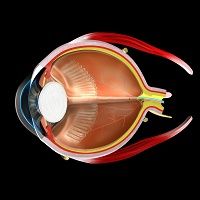Ranibizumab Reduces Retinopathy Severity in Patients with Diabetic Macular Edema
After 12 or 24 monthly injections, ranibizumab, one of three currently available vascular endothelial growth factor antibodies, caused regression of diabetic retinopathy (DR) in at least 75% of patients who had diabetic macular edema and whose DR severity put them at the highest risk of progression to proliferative DR.

After 12 or 24 monthly injections, ranibizumab (Lucentis, Genentech), one of three currently available vascular endothelial growth factor (VEGF) antibodies, caused regression of diabetic retinopathy (DR) in at least 75% of patients who had diabetic macular edema (DME) and whose DR severity put them at the highest risk of progression to proliferative DR (PDR). This conclusion emerged from a retrospective analysis by baseline disease severity of outcomes of the RIDE/RISE series of randomized phase 3 studies. These studies, which together included 759 patients with DR, compared 24 monthly injections of Lucentis, 0.3 mg or 0.5 mg, with sham injections.
A summary of the results of this analysis was presented by Charles Wykoff, MD, of the Blanton Eye Institute in Houston, TX, at the Association for Research in Vision and Ophthalmology Annual Meeting in Seattle, WA, on May 2, 2016, and published as an abstract in its proceedings. “Anti-VEGF pharmaceuticals given by intravitreous injection have revolutionized management of both DME and PDR and continue to shift our paradigm in many cases from primarily laser-based modalities to pharmacologic options,” Wykoff observed.
He added that the benefits of Lucentis were particularly evident in the one-third of patients in RIDE/RISE who had both DME and moderately severe or severe non-proliferative diabetic retinopathy (NPDR). Like such advanced disease, even less severe diabetic retinopathy “may have the potential to significantly impact our patients’ visual lives,” he noted. As an example, he cited the Los Angeles Latino Eye Study, which found that patients’ quality of life began to deteriorate when “just moderate NPDR” affected both eyes.
In RIDE/RISE, disease severity was graded with the DR Severity Scale by masked evaluators of seven-field fundus photographs, and patients were evenly distributed by disease severity among treatment groups. The analysis of RIDE/RISE by Wykoff and Genentech colleagues found that, among DME patients with moderately severe or severe NPDR, rates of reduction in severity of two steps or more were significantly greater for those who received either dose of Lucentis vs. placebo. These rates were 76% vs. 2%, respectively, after 12 months of treatment, and about 80% vs. 12%, respectively, after 24 months (P <0.0001 for both time points and doses vs. placebo). Also, after 24 months of treatment, 23% in the low-dose group and 28% in the high-dose group had a severity reduction of three steps or more, compared with 1% in the sham-treated group (P<0.0001).
Reduction in disease severity occurred regardless of baseline characteristics, including whether patients had macular nonperfusion shown by fluorescein angiography at baseline. However, after 24 months, the rate of macular nonperfusion doubled in sham-treated patients but remained stable in Lucentis-treated patients.
The analysis also found that very few patients treated with Lucentis had progression to PDR, which was much more common in sham-treated patients. After 12 monthly injections of Lucentis, no patients progressed to PDR at either dose, but 10% of sham-treated patients did. And after 24 monthly injections, no patient in the lower-dose group progressed to PDR, 3% in the higher-dose group did, and nearly 20% in the sham-treated group did.